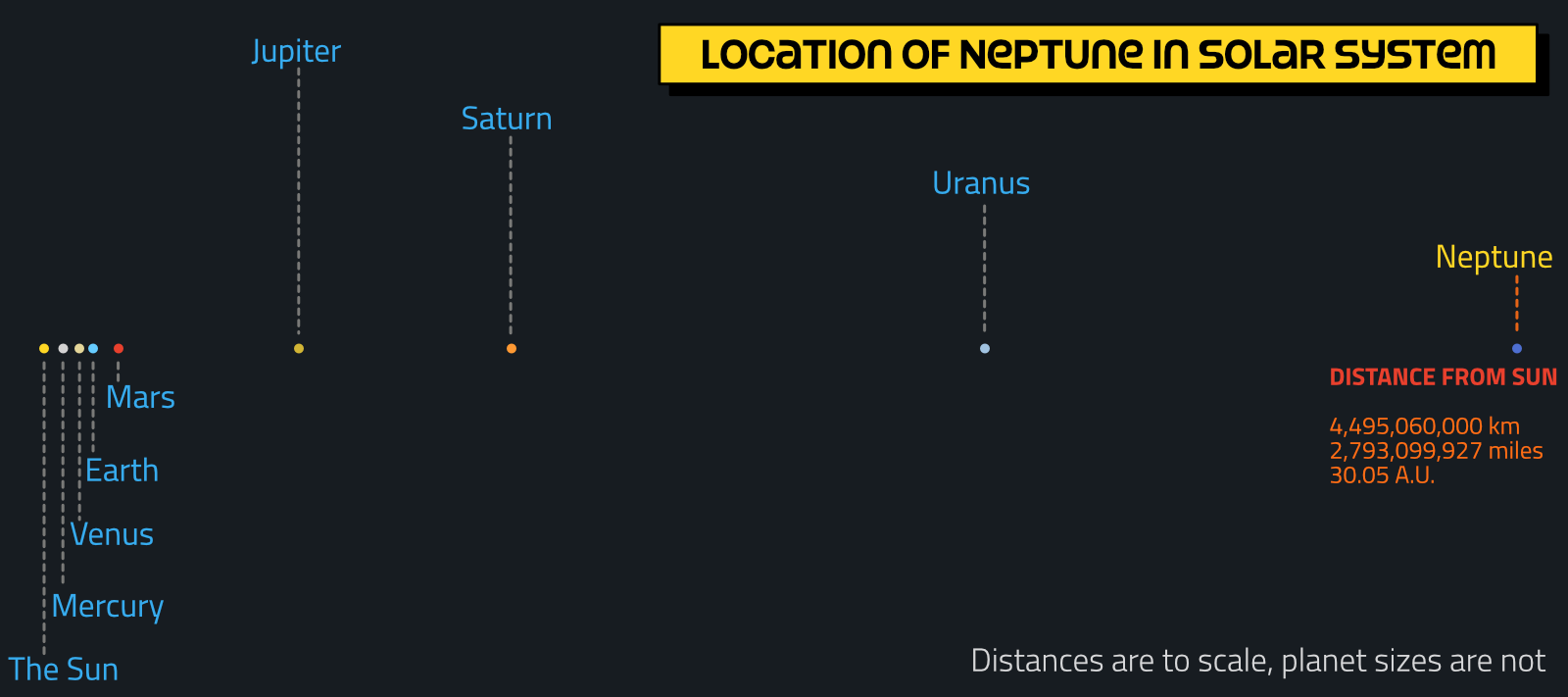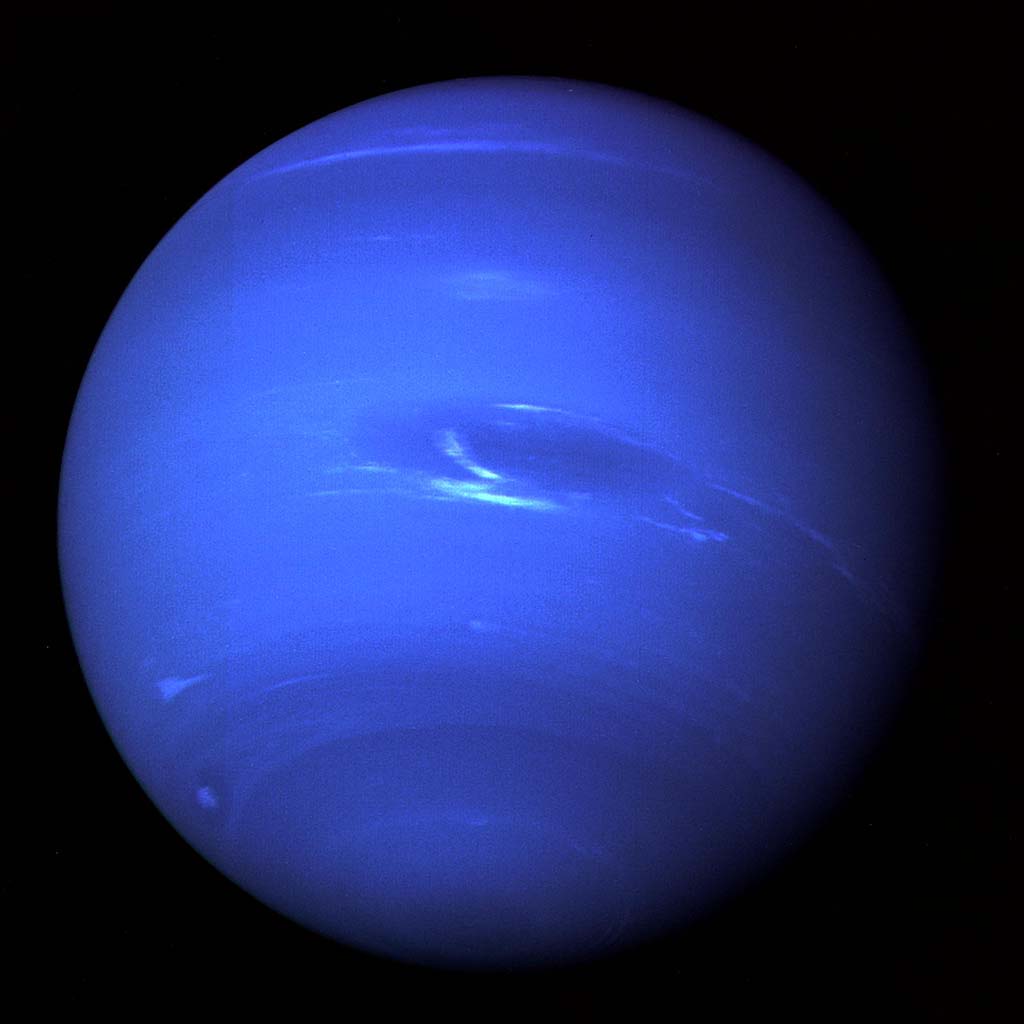Ten Facts about Neptune
Far far away from the Sun is Neptune, a planet that has only been known of for less than 200 years. Here are ten facts about the icy gassy giant.
Neptune is the eighth and most distant planet in the Solar System
Neptune orbits the Sun at the greatest distance of any of the eight planets. Its average distance from the Sun is about 4.5 billion kilometres or 2.8 million miles (4,495,060,000 kilometres / 2,793,099,927 miles). This is 30 times further from the Sun than Earth is. It is so far away that it is only visible with the aid of a telescope or a really good pair of binoculars. It takes almost 165 Earth years (164.8 years) for Neptune to complete an orbit of the Sun.
Neptune was discovered in 1846 by Urbain Le Verrier through the magic of mathematics and was first observed by Johann Gottfried Galle.
A lot of things in space are found simply by pointing telescopes in the sky and spotting them. Neptune was a bit different. Before astronomers went looking for it with their telescopes, its location was calculated first by the brainy French astronomer and mathematician Urbain Jean-Joseph Le Verrier. 65 years before Neptune was found, its neighbour Uranus was spotted by the English astronomer William Herschel. Observers of Uranus noticed that its orbit appeared to be disturbed by something, with the likely cause being the gravitational pull of a planet even further out. Monsieur Le Verrier put on his thinking hat and figured out the likely location of that planet. On 23rd September 1846, the German astronomer Johann Gottfried Gall and his student Heinrich Louis d'Arrest aimed their telescope at Le Verrier's recommended place in space and voila, they found the planet that would later become known as Neptune!
Neptune is the fourth largest planet by diameter in the solar system and is made up mostly of gas
Neptune has a diameter of 49,244 kilometers (30,599 miles). It is one of the gas giants, the four largest planets in the Solar System. These are Jupiter, Saturn, Uranus and Neptune. They are the four farthest planets from the Sun so are known as the outer planets. Neptune is actually the smallest of the outer planets, but is larger than all of the inner planets.
Methane in Neptune's atmosphere gives the planet its blue colour
Like all of the gas giants, Neptune is a giant ball of gas. Hydrogen and helium are the gases that make up most of Neptune, but about 1.5% of its atmosphere is methane. Methane absorbs red light and reflects blue light which causes the planet to appear blue.
Neptune has fourteen moons
There are fourteen moons in orbit of Neptune. The first to be discovered is Triton, which is also Neptune's largest moon. It was discovered on 10th October 1846 by English astronomer William Lassell, only 17 days after Neptune was first discovered. Over 100 years later in 1949, Nereid was found by Dutch astronomer Gerard Kuiper. A further 12 moons have been discovered since 1981.
Neptune's largest moon, Triton, is slowly but surely falling into the planet
Triton is Neptune's largest moon with a diameter of 2,707 kilometres / 1,680 miles. Triton is a bit of an oddity as it's the only large moon in the Solar System to have been captured by a planet's gravity rather than one which formed around it. Triton also orbits in an opposite direction to Neptune which appears to have the affect that it is slowly falling towards Neptune. Triton will eventually meet its end, but It's not known if it will just collapse into Neptune, or if it will be torn apart by Neptune's gravity. If it's the latter, it could give Neptune a spectacular set of rings similar to Saturn's. Such an event won't happen for another 3.6 billion years so we'll have to make do with a doodle of it instead.
Neptune has five dark rings
We don't need to wait 3.6 billion years for Neptune to form rings from Triton's eventual descent towards it. Neptune already has some. They're nowhere near as substantial as those that orbit Saturn, and are made of darker materials so are very faint, but we're sure that Neptune is quite pleased with his own set of rings. There are five rings orbiting around Neptune, named Galle, Le Verrier, Lassell, Arago and Adams. The Adams rings has brighter patches in it which look like arcs.
Neso is the most distant moon from its parent planet
Neptune's outermost moon is Neso. It orbits Neptune at a distance of over 48 million kilometres (36 million miles). This is the greatest distance that any moon is from its planet. Neso's huge distance from Neptune means that it takes almost 9,374 Earth days to complete an orbit of the planet. As a comparison, Earth's moon is only 384,399 kilometres (238,866 miles) from Earth.
Neptune is the Solar System's windiest planet
Average wind speeds on Neptune are around 1,130 kilometres per hour (700 miles per hour). This is speedier than the speed of sound. Woosh indeed! In Neptune's dark spots, which are especially stormy regions that come and go in the planet's atmosphere, wind speeds have been recorded as reaching up to 1,930 kilometres per hour (1,200 miles per hour). Double woosh!
Voyager 2 is the only spacecraft to have visited Neptune
In 1989, the spacecraft Voyager 2 flew by Neptune, sending back the first close-up images of the distant blue world. Voyager 2 originally launched in 1977, embarking on a mission to visit the outer planets. Prior to reaching Neptune, it had already been to Jupiter, Saturn and Uranus. While at Neptune, Voyager 2 discovered its dark spots and five of its fourteen moons. Voyager 2 is still active at the very outer edges of the Solar System.







